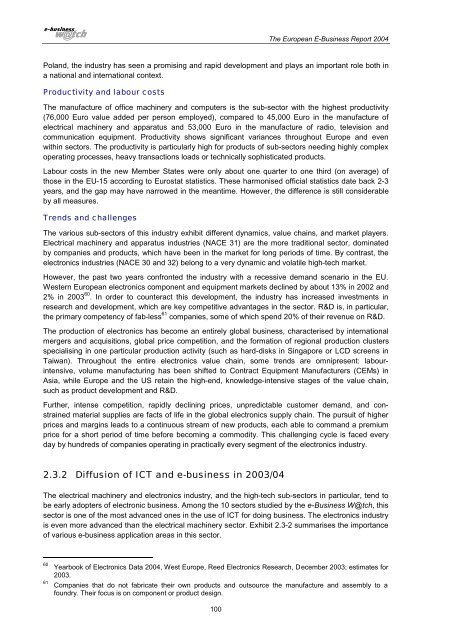The European e-Business Report 2004 - Berlecon Research GmbH
The European e-Business Report 2004 - Berlecon Research GmbH
The European e-Business Report 2004 - Berlecon Research GmbH
Create successful ePaper yourself
Turn your PDF publications into a flip-book with our unique Google optimized e-Paper software.
<strong>The</strong> <strong>European</strong> E-<strong>Business</strong> <strong>Report</strong> <strong>2004</strong>Poland, the industry has seen a promising and rapid development and plays an important role both ina national and international context.Productivity and labour costs<strong>The</strong> manufacture of office machinery and computers is the sub-sector with the highest productivity(76,000 Euro value added per person employed), compared to 45,000 Euro in the manufacture ofelectrical machinery and apparatus and 53,000 Euro in the manufacture of radio, television andcommunication equipment. Productivity shows significant variances throughout Europe and evenwithin sectors. <strong>The</strong> productivity is particularly high for products of sub-sectors needing highly complexoperating processes, heavy transactions loads or technically sophisticated products.Labour costs in the new Member States were only about one quarter to one third (on average) ofthose in the EU-15 according to Eurostat statistics. <strong>The</strong>se harmonised official statistics date back 2-3years, and the gap may have narrowed in the meantime. However, the difference is still considerableby all measures.Trends and challenges<strong>The</strong> various sub-sectors of this industry exhibit different dynamics, value chains, and market players.Electrical machinery and apparatus industries (NACE 31) are the more traditional sector, dominatedby companies and products, which have been in the market for long periods of time. By contrast, theelectronics industries (NACE 30 and 32) belong to a very dynamic and volatile high-tech market.However, the past two years confronted the industry with a recessive demand scenario in the EU.Western <strong>European</strong> electronics component and equipment markets declined by about 13% in 2002 and2% in 2003 60 . In order to counteract this development, the industry has increased investments inresearch and development, which are key competitive advantages in the sector. R&D is, in particular,the primary competency of fab-less 61 companies, some of which spend 20% of their revenue on R&D.<strong>The</strong> production of electronics has become an entirely global business, characterised by internationalmergers and acquisitions, global price competition, and the formation of regional production clustersspecialising in one particular production activity (such as hard-disks in Singapore or LCD screens inTaiwan). Throughout the entire electronics value chain, some trends are omnipresent: labourintensive,volume manufacturing has been shifted to Contract Equipment Manufacturers (CEMs) inAsia, while Europe and the US retain the high-end, knowledge-intensive stages of the value chain,such as product development and R&D.Further, intense competition, rapidly declining prices, unpredictable customer demand, and constrainedmaterial supplies are facts of life in the global electronics supply chain. <strong>The</strong> pursuit of higherprices and margins leads to a continuous stream of new products, each able to command a premiumprice for a short period of time before becoming a commodity. This challenging cycle is faced everyday by hundreds of companies operating in practically every segment of the electronics industry.2.3.2 Diffusion of ICT and e-business in 2003/04<strong>The</strong> electrical machinery and electronics industry, and the high-tech sub-sectors in particular, tend tobe early adopters of electronic business. Among the 10 sectors studied by the e-<strong>Business</strong> W@tch, thissector is one of the most advanced ones in the use of ICT for doing business. <strong>The</strong> electronics industryis even more advanced than the electrical machinery sector. Exhibit 2.3-2 summarises the importanceof various e-business application areas in this sector.6061Yearbook of Electronics Data <strong>2004</strong>, West Europe, Reed Electronics <strong>Research</strong>, December 2003; estimates for2003.Companies that do not fabricate their own products and outsource the manufacture and assembly to afoundry. <strong>The</strong>ir focus is on component or product design.100
















